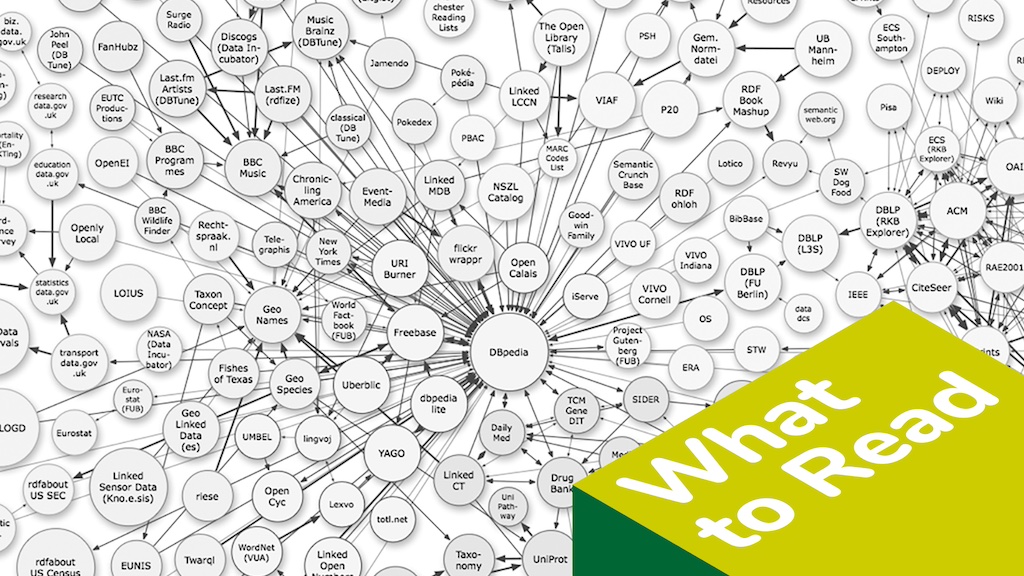This blog post is part of the series What to Read.
At the Land Portal Foundation we believe open access to information is crucial to achieve good land governance and to secure land rights for all, especially vulnerable groups. However not everyone is familiar with open data concepts in the land community. Often when we host webinars and other events, we observe enthusiasm for more open data, but also fears that making land data more open and accessible to everyone, anywhere and at no cost may increase inequity and endanger land rights. Neither the enthusiasm nor the fears are unjustified, and while we generally advocate for open land data, we are also advocates for informed debate.
For this What to Read Digest we prepared a selection of readings to give you a glimpse of the key issues, without intending to be comprehensive. We hope these readings will help to shed light on the role that open land data can play in equitable and sustainable development, and social justice, but also the power struggles behind open land data and the perspective from indigenous groups in this debate.
The readings are arranged in a specific sequence, from offering an overview to the subject to exploring how much land data has been made open to understanding open data risks, challenges and power relations.
We start by addressing how open data can support land administration systems for sustainable socio-economic and environmental management. This is followed by reflections on the risk that open data may increase inequality. The readings revisit the motivations for investing in open data and distinguish between “data accessibility” and “effective data use” to make positive change. We finish with a concrete example of how those risks can be prevented through the empowerment of those in vulnerable positions to deal with their own data coming from the First Nations in Canada.
We hope that disseminating these works helps us move forward into a future where the availability of data is only a starting point for improved decision making and delivery of essential land related services.
Sign up here to receive this digest in your mailbox
Open data for improved land governance
By Charl-Thom Bayer and Laura Meggiolaro, 2022
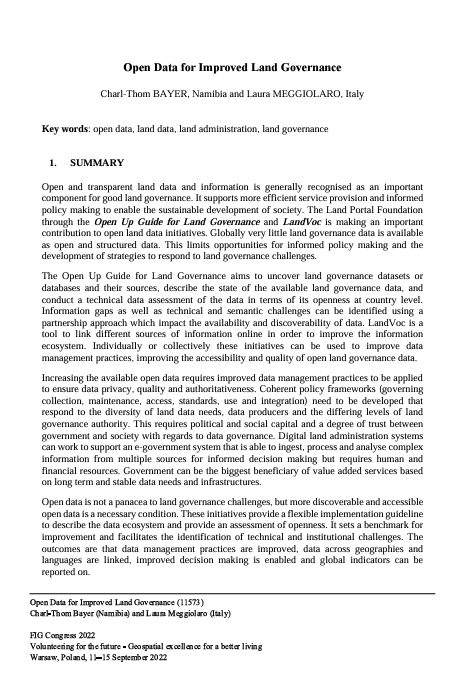
Governments are limited in their ability to formulate evidence-based policies and to develop strategic responses to those challenges in the absence of open and transparent land data. Yet, there is a globally poor record of publishing land administration data. This paper presents the contribution of the Land Portal to an open and transparent land ecosystem with two tools: the Open Up Guide for Land Governance and the LandVoc.
The purpose of the Open Up Guide for Land Governance is to open up country level data by fostering local capacity and open data literacy initiatives. It has three components: a description of the country’s land information ecosystem, a technical assessment of the data in terms of its openness, and the identification of data resources that can be published as open data.
The LandVoc is a standard controlled vocabulary with 310 land governance related concepts available in nine languages. This vocabulary responds to a lack of a structured and uniform approach to use vocabularies regarding land. It provides standardization in the language of land governance in a way that embraces differences, it makes data more discoverable, and it enriches the aggregation of external content.
In a time of increasing demands of data and technological innovation, and even if open data cannot solve all land governance challenges, open data is a necessary condition and institutions need to adopt measures to keep up with the changes while providing certainty and stability. These LP tools are designed to support governments and organisations in this endeavour using metadata, semantic vocabularies and the adoption of appropriate data standards.
Related readings:
Open Up Guide for Land Governance. Version 2.0
LandVoc. The Linked Land Governance Thesaurus
The state of open data. Histories and horizons
By Tim Davies, Stephen B. Walker, Mor Rubinstein and Fernando Perini (Eds.), 2019
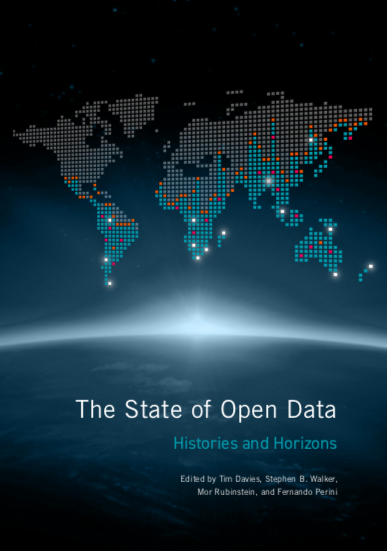
The State of Open Data offers an extended reflection about open data across sectors. Of particular importance to land governance is the chapter devoted to land ownership.
Even if data is an inexhaustible resource, the authors show how land data is at the mercy of power dynamics that are explained by the economic value and potential of land. The general picture of the availability of land ownership data and deals is incomplete, due in part to the high cost involved in producing and maintaining land data.
Another challenge is the one-way direction in the flow of data coming mainly from governments through registries and cadastres which signals an unequal distribution of power that prevents building open data infrastructures and ecosystems. The opportunity seen by the authors is in the diversification of data sources by empowering local communities to document their own land use and rights data.
Another issue addressed in the chapter is the delicate balance between making cadastral data “open by default” and protecting the privacy rights of individual owners, particularly considering the uneven distribution of the capacity to use data.
Indirectly related to land governance are the chapters on geospatial data -especially useful to obtain information on land use- and on the extractive industries. The latter covers two crucial aspects when it comes to open data: the accessibility of the data to a diversity of stakeholders and the quality of the data. They are crucial to empower the civil society and other stakeholders to hold the actors involved accountable.
The publication also addresses the links between open data and gender equity, indigenous data sovereignty and privacy, among others.
Open data: empowering the empowered or effective data use for everyone?
By Michael Gurstein, 2011
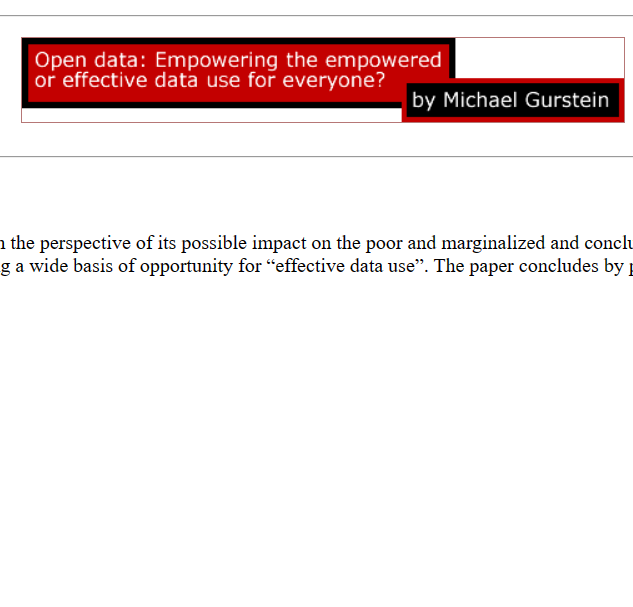
Even if written more than ten years ago, this paper points to a question very relevant today when it comes to the potential impact of open data on the poor and marginalised. The author raises awareness to the risk of “data divide” associated with the effort to extend access to data and shows examples where open data empowers the already empowered.
One of those examples is the impact of the digitization of the land records in Bangalore, India. Access to land ownership and title information allowed the middle- and upper-income people and corporations to challenge the titles, take advantage of mistakes in documentation and identify opportunities for bribery, resulting in unequal contests around land titles, court action and offers of purchase for self-benefit to gain ownership of land from the poor.
The author argues that one of the pre-conditions for an effective use of open data is to ensure that opportunities and resources for translating open data into useful outcomes are available to the widest range of users. This requires not only to make open data accessible but to provide the necessary conditions and skills to be able to use the data in an equal manner. With this purpose he proposes a model for effective data use with the following elements: internet, computers and software, computer and software skills, content and formatting, interpretation and sense making, advocacy and governance.
He concludes that if interventions on those levels are not made, not only open data will not be used by the poor but it can be used against the poor.
Related Readings:
Land Ownership and the State of Open Data, 2023
Open data: Lost opportunity or unrealized potential?
By Serdar Temiz, Marcus Holgersson, Joakim Björkdahl and Martin W. Wallin, 2022
 When an initiative is not giving the expected results, it is a good idea to take a step back and reflect on the original reasons to invest in it. This is what the authors of this paper do in response to the high promise of open data but the meagre results from it so far. Even if not focused on land data, the reflection is relevant to all sectors where open data is promoted.
When an initiative is not giving the expected results, it is a good idea to take a step back and reflect on the original reasons to invest in it. This is what the authors of this paper do in response to the high promise of open data but the meagre results from it so far. Even if not focused on land data, the reflection is relevant to all sectors where open data is promoted.
In a study developed in Sweden with public and private organisations, the authors find that the motivation behind open data is often about legitimacy-seeking rather than the creation of value from the use and re-use of data. To invest in open data simply to project a positive image or because peer organisations are doing it is considered an insufficient reason that might jeopardise investing in complementary assets needed to realise the potential of open data.
But, does it really matter why organisations engage in open data, as long as they do it? The authors’ answer is “yes” because it is not enough for data to be open, it should also be useful, usable, cleaned, technically and legally accessible, and there must be data analytics, software, quality management and social tools to create an ecosystem around open data.
The authors argue that motifs and beliefs need to align with investments to create value and that investments are at risk when the reason is clouded or insufficient. Ultimately, the value of open data lies in being used. If this is not the intention behind open data, necessary complementary investments might not be made. Public and private organisations interested in achieving this alignment will find at the end of the paper insights for practice.
A First Nations Data Governance Strategy
By First Nations Information Governance Centre (FNIGC), 2020
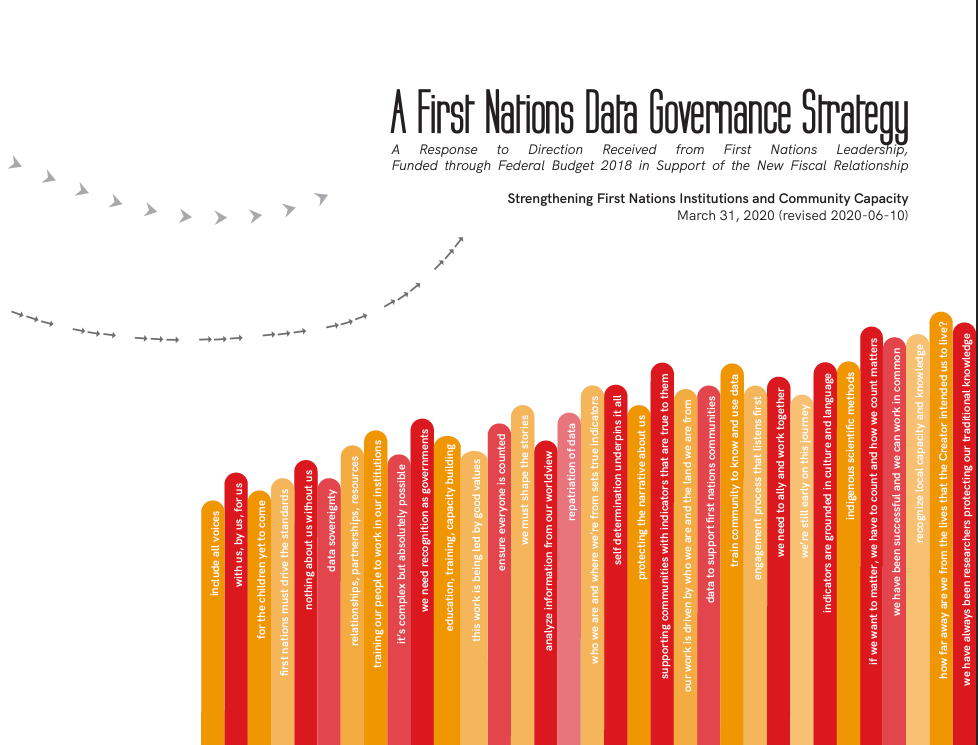
Since colonial time, First Nations in Canada have experienced a history of discrimination. Despite the advancements in the recognition of their rights, they keep facing inequality, for example, on who has the control of the information and data. They consider data sovereignty an inherent right and a transformational requisite to advance the indigenous self-determination and to rectify socio-economic inequalities. They argue that to build their own data and statistical capacities is a way to secure equal opportunities to participate, contribute and benefit from the global data revolution, as well as to unleash the power of their data and protect themselves against harm.
For this reason, they have designed a comprehensive data governance strategy that covers the whole cycle around data including its generation, collection, analysis, visualisation, protection, dissemination and consumption. This requires working in data access, storage solutions and analytic capacities.
The strategy is a good example of how to create value out of data by putting it at the service of the communities following a bottom-up approach to create a network of semi-autonomous regional centres. At the same time, it complies and collaborates with national levels of governance and policies to meet the needs of standardization, comparability and interoperability in support of data sharing and analysis across regions.
Other principles guiding the strategy is the intellectual property of all First Nations collectively (OCAP®) where First Nations are the owners of their data, they control what data, how and by whom is collected, they must have access and they have jurisdiction over data collected by them or about them. Besides, the strategy demands reciprocal and respectful relationships at all levels of government, which involves measuring the performance of provincial, territorial and federal governments in meeting their commitments to First Nations. It also reminds us that data responds to pre-conceived concepts and definitions and enriches our understanding of what is being measured by using quality community-driven standards and indicators grounded in First Nations language and culture, which, for example, might affect how individual health, wellness or land is understood and measured.
The strategy has nine pillars and the description of each pillar responds to the question: what is this about? What are the key impacts? Why is this important? Where do we want to go? How do we get there? And what is next?
Related readings:
Indigenous Peoples, Data, and the Coloniality of Surveillance
Indigenous Data Sovereignty and Policy

